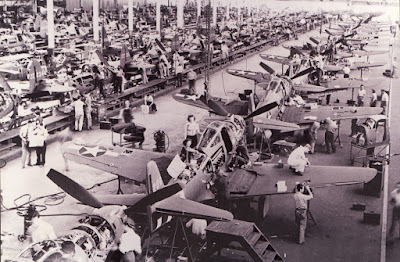 |
| Harry in 2000 and 1943. He was always a feminist to me. |
From 1939 until I went into the Army in 1943, I worked for the Bell Aircraft Corp in Buffalo and Niagara Falls. In the beginning, there were around 200 employees engaged in the business of building aircraft, of whom about 50 were engineers/designers, and the rest, like me, were factory workers doing the assembling, riveting, bolting, screwing, etc., physical factory work.
There were also a few women, secretaries, bookkeepers, etc., whom the men all whistled at whenever they caught a glimpse of them walking by. Halfway through 1940, when the draft started taking men away in droves, the war industry underwent an explosive expansion, and that’s when women were actively sought and encouraged to enter the factory work force. (Initially, men were drafted for one year, but when the war started for us at the end of 1941, the draft was for one year plus the duration, which turned out to be for four more years.) Actually, between mid-1940 and mid-1941, some 10,000 people were added to the workforce at Bell, and the same thing was going on in war plants all over the country. Some were older men, too old for the draft, and others who left lesser-paying jobs to work in the defense industries, but most were women, thousands of them.
By mid-1941, I was an old pro in the factory, at the ripe old age of 20. So I was made a foreman in the factory, mainly because most of the guys were being drafted so fast that I was getting seniority, and of course I had to teach the women how to do the required jobs – riveting, bolting, screwing and even how to use the tools, most of which operated on pneumatic (air) power rather than electricity. My section specialized in wings, flaps and ailerons, and part of the job required someone to crawl inside the wings to hold rivets on the inside, so size was important. Being small, I was able to do this, and the women were even better – smaller and agile. I got along well with them, though most of the men were merciless in harassing them. This was long before sexual harassment entered the vocabulary and I really felt sorry for the women and embarrassed by the crudeness of the men.
What became apparent, though, is that the women could do these jobs as well as or better than the men, and they were proving it every day in all the sections of the factory. By the time I left for the Army in the fall of ’43, there were 25,000 people working there, and maybe 20,000 of them were women. Mothers, daughters, aunts, sisters, grandmothers, sweethearts, even a few lesbians, according to the men who said they could recognize these things. All white, though, no blacks. We had a sizable number of black men, which was a departure for American industry at that time, but no black women. The country was still a segregated society then, and we haven’t made a lot of progress since then, either.
Anyway, I found the women to be smart, willing to learn, willing to work, willing to suffer humiliation and harassment, and willing to help in the war effort and to bring their men home quicker. They came in all sizes and shapes and temperaments and personalities, and I did my best to make them feel welcome and appreciated. I kept telling them that as soon as they became proficient at their jobs, I was going to go fight for them.
Copyright 2016, Elaine Blackman
 | |
| Photo from Airport Journals |

Great story!
ReplyDeleteGreat story!
ReplyDeleteAnother great story!!!
ReplyDelete